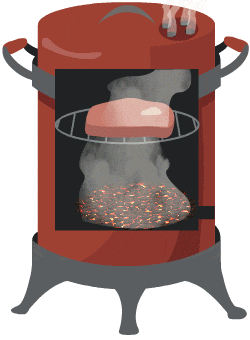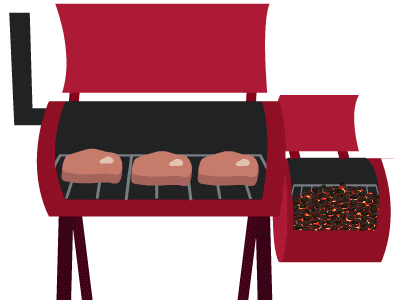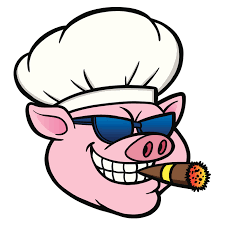Understanding Smokers
A smoker is essentially a specialized oven designed to cook food slowly while infusing it with flavorful smoke. In this quick guide, we’ll delve into the workings of smokers, what they do, what you need to operate one effectively, and the key components involved in the cooking process.
What is a barbecue smoker?
At its core, a smoker is an outdoor cooking appliance designed to cook food at low temperatures over a long period, typically using wood smoke to flavor and tenderize the meat. Unlike traditional grills or ovens, smokers are engineered to maintain a consistently low temperature, usually between 200°F and 275°F (93°C to 135°C), creating the ideal environment for slow-cooking meat to perfection.
What Does a Smoker Do?
The primary function of a smoker is to impart a rich, smoky flavor to the food being cooked. This is achieved by burning charcoal, wood chips, chunks, or pellets inside the smoker, generating smoke that envelops the meat. As the meat cooks slowly over several hours, it absorbs the aromatic compounds present in the smoke, resulting in a distinctive flavor that distinguishes smoked barbecue from other cooking methods.
How Does a Smoker Work?
The operation of a smoker revolves around the principles of controlled airflow and combustion. Typically, a smoker comprises the following components:
- Firebox: This is where the wood or charcoal is burned to generate heat and smoke. The firebox is located separate from the cooking chamber in offset smokers or directly below it in vertical smokers.
- Cooking Chamber: Also known as the smoking chamber, this is where the meat is placed for cooking. It is designed to maintain a low and consistent temperature, allowing the meat to cook slowly and evenly.
- Air Vents: These are strategically placed openings that allow for the regulation of airflow within the smoker. By adjusting the vents, users can control the intensity of the fire and the amount of smoke produced.
- Smokestack or Chimney: Located at the opposite end of the smoker from the firebox, the smokestack serves as an exhaust vent, allowing smoke and heat to escape from the cooking chamber. It is also strategically placed to creat for the best airflow path.
- Temperature Gauge: Many smokers are equipped with built-in thermometers or temperature gauges to monitor the internal temperature of the cooking chamber, ensuring precise control over the cooking process.
Visualizing how a smoker works
The basic operation of a smoker involves igniting the fuel in the firebox, regulating airflow to maintain the desired temperature, and adding wood chips or chunks to produce smoke. As the smoke circulates around the meat in the cooking chamber, it imparts its distinct flavor, gradually transforming the raw ingredients into succulent, smoky barbecue.
The basic principle is quite simple. You need an air intake lower on your smoker to feed the fuel and some sort of wood to burn that creates smoke which swirls around the meat and exits through a vent higher up.
How A Smoker Works Diagram

Since heat rises, it creates a natural flow entering and exiting.

By opening the lower and upper vents, you allow more oxygen to flow through and this will increase heat and smoke.
What Do You Need for a Smoker?
To operate a smoker effectively, you’ll need the following essential components and accessories:
- Fuel: Whether it’s charcoal, wood chunks, chips, or pellets, selecting the right fuel is crucial for achieving the desired flavor profile. Experimentation with different types of wood, such as hickory, mesquite, apple, or cherry, can impart unique flavors to your smoked dishes.
- Fire Starters: To ignite the fuel in the firebox, you’ll need fire starters or kindling to get the fire going. Options include charcoal chimneys, electric starters, or natural firelighters. (Electric smokers are of course expempt from this.)
- Thermometer: Accurate temperature monitoring is essential for successful smoking. Invest in a reliable meat thermometer or use the built-in temperature gauge on your smoker to ensure precise control over the cooking process.
- Wood Chips or Chunks: These and/or wood pellets are important for generating smoke. Larger wood chunks will provide for a longer-lasting smoldering effect.
- Drip Pan: Placing a drip pan beneath the meat helps collect excess fat and juices, preventing flare-ups and maintaining a clean cooking environment.
- Barbecue Tools: Long-handled tongs, spatulas, and brushes are indispensable for handling hot food and surfaces inside the smoker.
- Seasonings and Rubs: Enhance the flavor of your smoked dishes with a variety of seasonings, rubs, and marinades tailored to your taste preferences.
Different Types of Smokers
Smokers come in a variety of designs and configurations, each offering its own set of advantages and drawbacks:
- Offset Smokers: Characterized by a separate firebox adjacent to the cooking chamber, offset smokers allow for indirect heat and smoke flow, resulting in even cooking and enhanced smoke flavor.
- Vertical Smokers: Also known as bullet or cabinet smokers, vertical smokers feature a vertical design with the firebox at the bottom and multiple racks for food placement above. They are compact and efficient, making them ideal for backyard barbecue enthusiasts.
- Pellet Smokers: Utilizing compressed wood pellets as fuel, pellet smokers offer convenience and precise temperature control through automated pellet feeding and electronic temperature regulation.
- Electric Smokers: Powered by electricity, these smokers are easy to use and maintain, making them suitable for beginners. They offer consistent temperature control but may lack the authentic smoke flavor produced by traditional wood-burning and charcoal smokers.
A smoker is a versatile outdoor cooking appliance that allows enthusiasts to create tender, flavorful barbecue with distinct smoky undertones. By understanding the basic principles of smoking and investing in the necessary equipment and accessories, anyone can master the art of smoked barbecue and elevate their outdoor cooking experience. Whether you prefer the traditional charm of offset smokers or the convenience of pellet or electric models, the key lies in patience, experimentation, and a passion for good food. So fire up your smoker, embrace the aromatic allure of wood smoke, and embark on a flavorful journey into the world of barbecue mastery.
